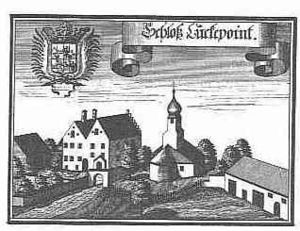Burgstall Luckenpaint
| Burgstall Luckenpaint | ||
|---|---|---|
|
Luckenpaint Castle after an engraving by Michael Wening from 1721 |
||
| Alternative name (s): | Luckenpaint Castle | |
| Creation time : | 12th to 13th centuries | |
| Castle type : | Location | |
| Conservation status: | Burgstall, castle chapel | |
| Standing position : | Nobles | |
| Place: | Thalmassing - Luckenpaint | |
| Geographical location | 48 ° 53 '39.9 " N , 12 ° 8' 8.7" E | |
| Height: | 420 m above sea level NN | |
|
|
||
The Burgstall Luckenpaint , also called Luckenpaint Castle , is an abandoned castle in the Luckenpaint district (Schlossberg 9) of the Thalmassing municipality in the Upper Palatinate district of Regensburg in Bavaria .
history
In 866 the noble widow Ekkilind donated her property to the monastery of St. Emmeram in Luckenpaint ( in uico qui dicitur Ucchinpiunt ). The name Ucchinpiunt , which existed until the 15th century, is derived from the personal name Ucko and piunt (derived from the Old High German word biunta , which meant a plot of land).
Towards the end of the 10th century there was another donation from the possession of a Himiltrud , wife of the Free Perinher under the abbot Wolfgang von Regensburg to St. Emmeram. In another donation, the husband is named Perinher von Luckenpaint . Between 1048 and 1060 the noble Altman received a fiefdom from the Luckenpaint monastery . In the second half of the 12th century, the monastery ministeriale Kuno von Luckenpaint and his son Irmfried are mentioned in the Emmeram traditions. Kuno is the son of Heinrich von Lauterbach , who was also in the service of the monastery. Around 1212 an Albert von Tygingen (Teugn) received the returned Luckenpaint again as a fief. The castle, the construction of which is not known, was probably built between the 12th and 13th centuries by the Lords of Luckenpaint .
In 1287 a fortification is mentioned in Luckenpaint ( municipio in Ukenpiunt ). The heirs of the deceased previous owner Heinrich Klafschink received the complex from St. Emmeram Abbot Wernher (1279–1292) as a fief on the mediation of the Bavarian Duke. Luckenpaint remained in this family until after 1311. After that, a Ruprecht named himself after Luckenpaint. In 1323 he still appeared as Ruprecht von Luckenpaint , later he appeared as Ruprecht von Haidau (his brother was formerly the district judge of Haidau ). In 1332 he had his body rights confirmed for the law of Uchkenpeunt for himself, his wife and his son. This Ruprecht seems to have died around 1341, as his widow was making a sea equipment foundation for her deceased husband. In 1380 a Heinrich Schick zu Luckenpaint is mentioned here . The Ukchenpeunt fortress was mentioned in 1390 when its owner at the time, Ulreich der Schikch von Ukchenpeunt, reached an agreement with the citizens of Regensburg about the damage to his castle. What caused this damage does not seem to be clear; possibly Ulreich the Schikch waged war against the Regensburg war.
At the end of the 14th century, Luckenpaint came to the Pfeffenhauser . In 1581 it was sold to Georg von und zu Wichsenstein . From 1629 until the beginning of the 19th century, Luckenpaint is owned by the Lerchenfelder . The castle was rebuilt in the 17th century .
In 1803 Luckenpaint came to the Stadtamhof district court as part of the state reorganization. 1857 came from there to the district court of Regensburg, just from Rentamt Stadtamhof to Rentamt Regensburg.
Luckenpaint Castle then and now
The engraving by Michael Wening from 1721 shows a double-gabled house with a stepped gable , next to it a commercial building can be seen; both are surrounded by a wall through which a simple gate leads. Outside the wall of the castle is the castle chapel , which was then provided with an onion dome . On a map by Philipp Apian , under Luckenpaint, a castle with a tower, palas and bering is drawn. The castle or palace has been in ruins since the middle of the 18th century.
Nothing is left of the former castle complex. In 1833 there was supposed to have been a deep moat on the west side of the castle ruins, probably the rest of a protective system that encompassed this castle. The last remains of the wall are said to have been removed in 1954.
From the later palace construction, the St. Lawrence Palace Chapel has been preserved. This contains Romanesque components, but was redesigned in the 18th century. The epitaph of Georg von und zu Wichsenstein, who died in 1606, is located in the church .
literature
- Andreas Boos: Castles in the south of the Upper Palatinate. The early and high medieval fortifications of the Regensburg area (= Regensburg Studies and Sources on Cultural History , Volume 5). Universitätsverlag Regensburg, Regensburg 1998, pp. 273-275, ISBN 3-930480-03-4 (Dissertation University of Regensburg 1993, under the title: The early and high medieval castles in the south of the Upper Palatinate , 471 pages).
- Diethard Schmid: Regensburg I. The district court Stadtamhof, the imperial rule Donaustauf and Wörth. (= Historical Atlas of Bavaria, part: Altbayern, issue 41). Commission for Bavarian State History , Michael Laßleben , Munich 1976, ISBN 3-7696-9904-1 .
Individual evidence
- ↑ Andreas Boos, 1998, p. 375.
Web links
- Entry on Luckenpaint Castle in the private database "Alle Burgen".




